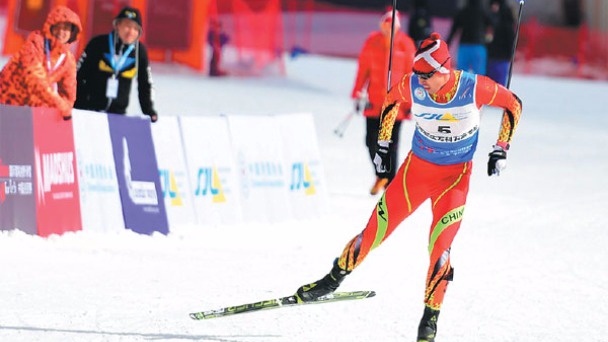
The 2018 China Tour De Ski wrapped up at Vanke Shijinglong Ski Resort in Beijing on Tuesday after providing yet more evidence of the country's burgeoning love affair with winter sports.
The FIS cross-country skiing series, which featured five stages in four different locations in China, offered local talent the chance to compete against top foreign opposition in preparation for the 2022 Winter Olympics here.
Swedish pair Simon Persson and Lisa Svensson won the Beijing stage's men's and women's titles, but there was plenty to cheer for Chinese athletes too, with Wang Qiang taking the runner-up spot in the men's race and Qu Ying finishing fourth in the women's event.
"This has been an excellent chance for every skier to gain more experience and compete with top foreign skiers," said Qu.
"Not every Chinese skier can compete abroad, but now we have international events at home.
"There is still a gap between Chinese skiers and top foreign skiers, and this is a golden opportunity for us to train and learn."
Wang concurred, saying: "This is an amazing resort and the tour is invaluable to us. Although there is a gap, I still believe the domestic skiers look promising for the future."
The tour, in its 11th edition, included stops in Beijing, Yan'an in Shaanxi province, and Changbai Mountain and Changchun in Jilin province.
The tour's ambassador is Bjorn Lind, a legendary Swedish cross-country skier who competed in three Winter Olympics and won gold medals in both the individual and team sprint events at Turin in 2006.
Lind told China Daily the tour offered encouraging signs for the local contingent.
"We have been doing the Tour De Ski for several years now; we have kept growing and the interest is growing in China," said Lind.
"The Chinese skiers are getting better and better. The tour is of great value to Chinese skiing and to the 2022 Olympics.
"It's not a very long time before the Winter Games come to Beijing. If you're focusing on the Winter Games, you have to train hard and put all of your energy into skiing."
Boom time
The tour is another example of the surging popularity of winter sports in China, driven by the country's commitment to involve 300 million people in winter sports activities in the lead-up to the 2022 Beijing Olympic and Paralympic Winter Games.
"We have been trying to host more important events on the International Ski Federation (FIS) calendar," said Chen Yingbiao, deputy director of the winter sports administrative center of the General Administration of Sport of China.
"This is for two reasons: First, we want to gain more experience hosting international winter sports events, including the logistics support, services for athletes, media and so on.
"Also, we want our skiers to gain more experience against international competitors through these events."
Gou Zhongwen, director of the General Administration of Sport of China, called for the full support of the country's sports sector in order to further promote winter sports.
Despite playing catch-up with the West, recent investment in infrastructure is transforming the winter sports scene here from a niche sector isolated in northeastern China to a mass sporting activity widely embraced across the country.
China aims to build a total of 650 skating rinks and 800 ski resorts by 2022, laying the foundation for the winter sports sector to generate a projected 1 trillion yuan from spending at venues, equipment production and training fees by 2025.
By the end of 2016, China had 646 ski resorts in operation and 11.3 million skiers, who ski at least once a year, according to the annual report on the development of the ski industry in China.
"I'm really impressed by the resorts and other infrastructure (in China), and everything is growing very fast in China," said Lind.



